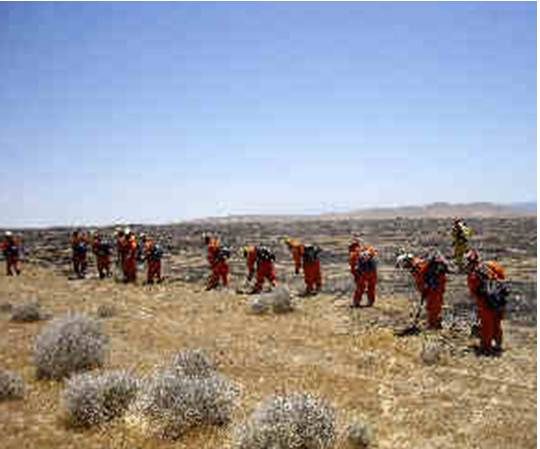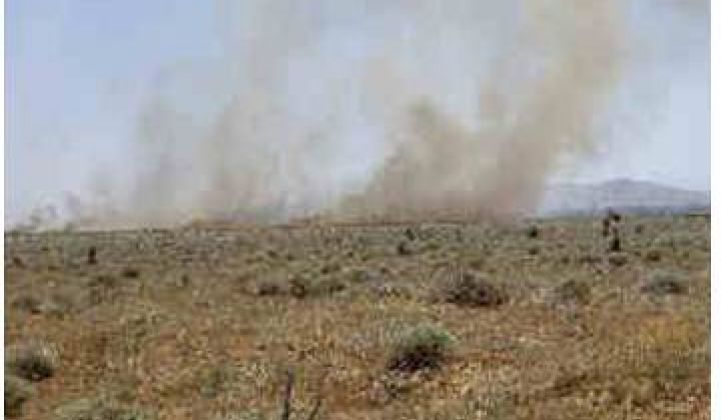In response to a fire at First Solar's proposed 230-megawatt photovoltaic (PV) Solar Ranch One site, where construction on the world's biggest PV power plant was supposed to begin July 5, the developer is about to see more hostility from the community of Fairmont, its Antelope Valley neighbor.
Fairmont Town Council Secretary David Jefferies, also an attorney, called the July 2 fire "negligence" and possible "reckless disregard" by First Solar (FSLR: NASDAQ). The fire burned over 70 acres before a 90-minute response from County firefighters suppressed it. LA County Fire Department Battalion Chief Clifford Meridth said it was the “accidental” result of a truck driving across the property.
"If you drive a vehicle with a hot engine through three-foot-tall, bone-dry grass, you're either ignorant or negligent," Jefferies insisted. “The company claims it wants to be a good neighbor,” Jefferies said, "but good neighbors don't start fires, especially at this time of the year.”
Jefferies also raised questions about possible First Solar operational safety violations, including failing to have fire suppression equipment on site, failing to have water trucks on site and failing to have a fire safety officer present. He claimed First Solar could be held responsible for fire-fighting costs. Fairmont's apparent intention to pursue legal remedies is an indication of the hostility between the community and the company.

“First Solar is investigating the incident and has spoken to local fire officials,” said company spokesman Alan Bernheimer. He pointed out that it was officially ruled accidental, but added that First Solar “will ensure that if any neighbors suffered damages from the fire, they will be fairly compensated.”
Bernheimer confirmed the cause of the fire. “The truck belonged to a technical consulting firm doing survey work on the project for upcoming site soils testing,” he reported. When construction starts later this month, “First Solar will have a fire safety plan in place,” Bernheimer promised. “Active First Solar construction sites always have safety personnel present.”
When First Solar set out to develop Solar Ranch One in 2008, it was directed to the nearby Antelope Acres Town Council. Following over 100 stakeholder meetings, the company conformed to all federal, state and local guidelines in obtaining the project’s permit. It also paid $140,000 in financial considerations to Antelope Acres, which is roughly 12 miles from the project site.
Fairmont, an agricultural community founded in the nineteenth century that is literally across the street from Solar Ranch One, constituted a Town Council in November 2010, after FSLR’s preparations were complete. Fairmont’s subsequent attempts to get the developer to recognize it and negotiate considerations went unanswered.
Jefferies said Fairmont is prepared to take further legal action. It may seek an injunction to delay construction. “We are not against renewable energy,” he insisted, but “we have five attorneys with hundreds of years of [accumulated] legal experience in our group,” Jeffries said, and “First Solar is unreasonably threatening our way of life. 'Unreasonably' is the important word."

Fairmont’s people are adamant about on-the-ground matters, including fences that will surround the installation, desert recreation area access, dust coming off the cleared and leveled land, and wildlife that may be displaced to nearby yards.
They are even more concerned with how much water Solar Ranch One operations will require, who will administer desert lands purchased to mitigate the project’s impacts, who will get the jobs at Solar Ranch One, and what public benefits First Solar will offer the community. Water concerns might be overblown -- First Solar does not wash the panels, according to the firm.
First Solar said its cadmium telluride (CdTe) PV project will use no more water on the 4,000-acre site than would be used by 12 houses. Fences will be set back to limit aesthetic objections and placed off the ground to accommodate wildlife. Dust will be kept in check during construction by water and solvents and during operation by re-vegetation. There will be recreational access to the site. Three hundred construction and 20 permanent jobs will go to locals -- if Fairmont does not block Solar Ranch One.
“We will continue to meet with the parties concerned to reach a mutually acceptable resolution,” Bernheimer promised.
First Solar Development Director Jack Pigott said at a June 27 Fairmont Town Council meeting that construction would begin July 5. It did not. If work on the project does not get significantly started by September 30, it stands to lose hundreds of millions of dollars in federal financial provisions, including a $680 million DOE loan guarantee awarded just last week.
And there is evidence of another potentially serious problem for First Solar. Investors in the solar energy industry’s premier stock seem jumpy. Two separate sources reported that as many as 10 major financial institutions have been making inquiries locally about the project’s impeded progress. Emails obtained by Greentech Media show that international banking giant Credit Suisse as well as Greenlight Capital and Maxim Group are among them.
First Solar’s Bernheimer declined to comment on this.
Fairmont only wants, Jefferies said, for First Solar “to do the best job they are capable of doing.” But, he went on, “the fire is symptomatic of their attitude.”
Fairmont’s people, Jefferies said, "are aware that we need to free ourselves from dependence on foreign oil. We are aware that U.S. nuclear capacity will likely not expand. We are aware there are serious questions about coal. And we are aware that the Western Antelope Valley is the place for solar and clearly the place for wind.”
But, Jefferies said of First Solar, “They think we don’t exist.”



